Why this resume works
- Quantifies accomplishments: Measurable accomplishments, such as leading a team of 25 creatives to boost productivity by 30%, highlight the applicant’s impact and value.
- Showcases career progression: The applicant’s journey from senior graphic designer to creative director reflects significant career progression, highlighting increased responsibility and leadership in managing larger teams and budgets.
- Illustrates problem-solving ability: By implementing a new design strategy that raised ROI by 40%, the applicant showcases their problem-solving skills and innovative thinking.
More Creative Director Resume Examples
Check out more creative director resume examples that showcase leadership, design expertise, and project vision. These graphic design resume samples will help you build a resume that stands out to employers in the creative industry.
Art Director
Why this resume works
- Effective use of keywords: Incorporating role-specific keywords like “creative direction” and “brand development” improves the resume’s chances of passing applicant tracking systems (ATS) and standing out to hiring managers.
- Shows digital literacy: Mastery of tools like Adobe Creative Suite showcases computer skills and digital readiness for modern workplaces.
- Centers on academic background: A master’s degree in graphic design emphasizes the applicant’s strong academic foundation, pivotal for early-stage career growth.
Brand Director
Why this resume works
- Points to measurable outcomes: By presenting achievements like boosting brand recognition by 25% and driving $2 million in revenue, the applicant effectively showcases their impact on company growth through measurable results.
- Demonstrates language abilities: The applicant’s language skills in Spanish, French, and Mandarin improve their communication skills for global campaigns.
- Displays technical expertise: Possessing certifications like Certified Brand Specialist and expertise in SEO optimization demonstrates the applicant’s solid technical foundation essential for driving brand strategies effectively.
Chief Creative Officer
Why this resume works
- Showcases impressive accomplishments: By showcasing standout achievements like leading a $2M project, the applicant effectively emphasizes their senior-level performance and significant business impact.
- Focuses on work history: Using a chronological resume format to detail roles from chief creative officer to art director highlights extensive career experience.
- Sections are well-organized: Clear headers and bullet points make the resume easy to scan, improving reader-friendliness while presenting complex information efficiently.
Creative Director Resume Template (Text Version)
Jennifer Parker
Chicago, IL 60605
(555)555-5555
Jennifer.Parker@example.com
Professional Summary
Dynamic creative director with 9 years boosting brand visibility and leading teams. Expert in graphic design and brand strategy, driving user engagement by 40%. Proven track record of increasing ROI and managing high-budget projects.
Work History
Creative Director
Visionary Media Solutions – Chicago, IL
June 2022 – October 2025
- Led a team of 25 creatives, boosting productivity by 30%
- Implemented new design strategy, increasing ROI by 40%
- Managed project budgets of up to $500,000
Art Director
Creative Minds Inc. – Chicago, IL
June 2017 – May 2022
- Directed branding projects, elevating brand visibility by 25%
- Oversaw art team, achieving deadline adherence 95%
- Enhanced user experiences across platforms, gaining 50K new users
Senior Graphic Designer
Innovative Design Studios – Chicago, IL
June 2014 – May 2017
- Designed 200+ marketing materials, increasing engagement by 20%
- Collaborated with cross-functional teams, driving 15% revenue growth
- Developed visual content strategies, boosting web traffic by 35%
Skills
- Creative Direction
- Art Direction
- Graphic Design
- Brand Strategy
- Team Leadership
- Project Management
- User Experience Design
- Digital Marketing
Education
Master of Fine Arts Graphic Design
University of Southern California Los Angeles, California
June 2013
Bachelor of Arts Visual Arts
University of California, Los Angeles Los Angeles, California
June 2011
Certifications
- Certified Graphic Designer – American Institute of Graphic Arts
- Creative Leader Certification – LinkedIn Learning
Languages
- Spanish – Beginner (A1)
- French – Intermediate (B1)
- Italian – Beginner (A1)
Related Resume Guides
Advice for Writing Your Creative Director Resume
Dive into our tips on how to write a resume tailored for a creative director role. Discover how you can highlight your visionary leadership, innovative projects, and unique artistic flair to stand out from the crowd. Whether you’re crafting compelling narratives or designing bold campaigns, these strategies can help you showcase your creative talents and career achievements effectively.
Showcase your portfolio or projects
For a creative director, including a portfolio or projects on your resume is essential to proving your skills and creativity. This kind of role requires a strong visual presence to demonstrate your style and ideas effectively. When you link to an online portfolio like Behance, Dribbble, or a personal website, it allows potential employers to see what you’re capable of creating.
Including select projects directly on your resume can also help make your work more accessible at first glance. Remember that freelance work, academic projects, and side projects are worth including. These experiences show versatility and the ability to handle different kinds of creative challenges.
To structure these entries well, treat them like job experiences: start with the project’s name and mention the client or company if applicable. Provide a brief description that highlights what the project was about and detail your key contributions along with the impact of your work.
This helps potential employers visualize how you think creatively as a director, setting the stage for discussions about how you can bring value to their team through innovative ideas and leadership.
Example of a projects section
360-degree branding campaign for tech startup
Innovatech Labs
March 2023 – August 2023
- Developed and executed a full-scale branding strategy, including logo design, typography guidelines, and color palette.
- Directed the production of a promotional video series that increased online traffic by 35%.
- Designed marketing assets for social media platforms and trade shows, improving brand visibility.
Immersive art installation for urban gallery
Cityscape Arts Collective
September 2022 – February 2023
- Conceptualized and directed an interactive art exhibition showcasing augmented reality elements.
- Worked with a team of artists, developers, and set designers to create an engaging visitor experience.
- Increased gallery attendance by 50% during the installation period through strategic event promotion.
Need help with your resume? Check out our professional resume examples to see layouts and ideas that’ll make yours stand out.
Emphasize your most relevant skills
As a creative director, it’s crucial to highlight both technical and soft skills on your resume. Technical skills—such as proficiency with Adobe Creative Suite, Sketch, or other design software—are essential for bringing creative ideas to life. Equally important are soft skills like leadership, problem-solving, and communication, which enable you to guide teams, collaborate with clients, and manage projects effectively.
To showcase these abilities, include a dedicated skills section listing the software and creative tools you excel at, along with artistic strengths such as graphic design, video editing, or visual storytelling. Strengthen your resume further by weaving these skills into your work experience.
For instance, instead of merely stating that you led a project team, describe how your leadership helped the team meet tight deadlines while leveraging specific design tools to deliver outstanding results.
By integrating skills throughout your resume, you tell a compelling story of your capabilities as a creative director. This approach not only highlights what you can do but also demonstrates how you’ve successfully applied your skills in real-world situations, making it clear to potential employers the value you bring.
For a creative director role, showcase your leadership in innovative projects and design skills by selecting a resume format tailored for creative professionals.
Choose a professional resume template
Choosing the right resume template for a creative director role involves finding a balance between creativity and professionalism. Look for clean, structured designs that highlight your skills and experience without being too flashy.
A template with a clear visual hierarchy helps guide the reader’s eye through your achievements. Opt for layouts with distinct sections like experience, skills, and education, ensuring each part is easy to read.
While it’s important to showcase your creative flair, keep in mind that simple elegance often makes the strongest impression. When selecting a template, consider one optimized for ATS compatibility. Many companies use applicant tracking systems to filter resumes before they reach human eyes, so your design mustn’t hinder this process.
Choose formats that use standard fonts and avoid complex graphics or tables that may confuse these systems. By choosing a streamlined yet visually appealing template, you’ll effectively communicate both your professional expertise and creative talent as a creative director.
Show off your creative director skills with our Resume Builder. It’s easy to highlight your experience and design expertise using templates that you can tweak to match your style.
Format your resume properly
A proper resume format is key for a creative director’s resume to ensure readability and a professional look. Applicants with extensive experience should use a chronological format to highlight their career path, showcasing growth and accomplishments over time. Those with less experience can choose a functional format to emphasize creative skills and projects, helping them stand out more effectively.
5 resume formatting tips
- Use clear section headings: Structure your resume with headings like “work experience,” “skills,” and “portfolio” for clarity.
- Choose consistent fonts: Select a readable font like Arial or Calibri in 10-12 pt for uniformity.
- Use bullet points: Present skills and achievements in brief, scannable bullet points for quick reading.
- Keep it concise: Limit resumes to one page unless you have extensive experience worth detailing.
- Ensure proper spacing and alignment: Maintain clean spacing and alignment to create a professional, easy-to-read layout.
Make your resume shine! Our ATS Resume Checker reviews your resume and provides quick feedback to improve your chances with hiring managers.
FAQ
Do I need to include a cover letter with my creative director resume?
Yes, including a cover letter with your creative director resume is highly recommended to showcase your unique vision and leadership skills.
A cover letter provides an opportunity to highlight specific accomplishments in branding, campaign strategy, or team management that align directly with the company’s needs.
Discuss how you spearheaded a successful rebranding project or led a creative team through innovative campaigns that grew market share.
Using tools like our Cover Letter Generator can save time while helping you craft a professional and personalized message tailored to this high-level role.
You may also find inspiration by reviewing cover letter examples designed for creative professionals to ensure yours effectively communicates your strengths and enthusiasm.
How long should a creative director’s resume be?
For a creative director, a two-page resume is often suitable to showcase your extensive experience, diverse portfolio, and leadership roles. This length allows you to detail significant projects and achievements without being overly verbose.
However, if you’re early in your career or have fewer notable projects, a one-page resume may be more effective in delivering a focused message.
Ultimately, how long a resume should be depends on the depth of your experience and the impact of your work. Ensure each section reflects your creative vision and strategic accomplishments.
How do you write a creative director resume with no experience?
Writing a resume with no experience for a creative director role might seem challenging, but you can highlight transferable skills and creative projects to showcase your potential effectively. Here are a few tips to help you get started:
- Highlight relevant education: Start by listing any degrees or courses in graphic design, marketing, or communications. Include any honors or special projects related to creativity and leadership.
- Showcase personal projects: If you’ve worked on personal creative projects like designing branding for a friend’s business or creating a portfolio of digital art, detail these initiatives to demonstrate your hands-on experience.
- Emphasize transferable skills: Skills like leadership, collaboration, strategic thinking, and innovation are important for a creative director. Highlight experiences where you’ve demonstrated these abilities in different settings.
See our guide on writing a resume with no experience for more detailed advice on crafting a resume specifically tailored to entry-level creative director positions.
Rate this article
Creative Director
Additional Resources
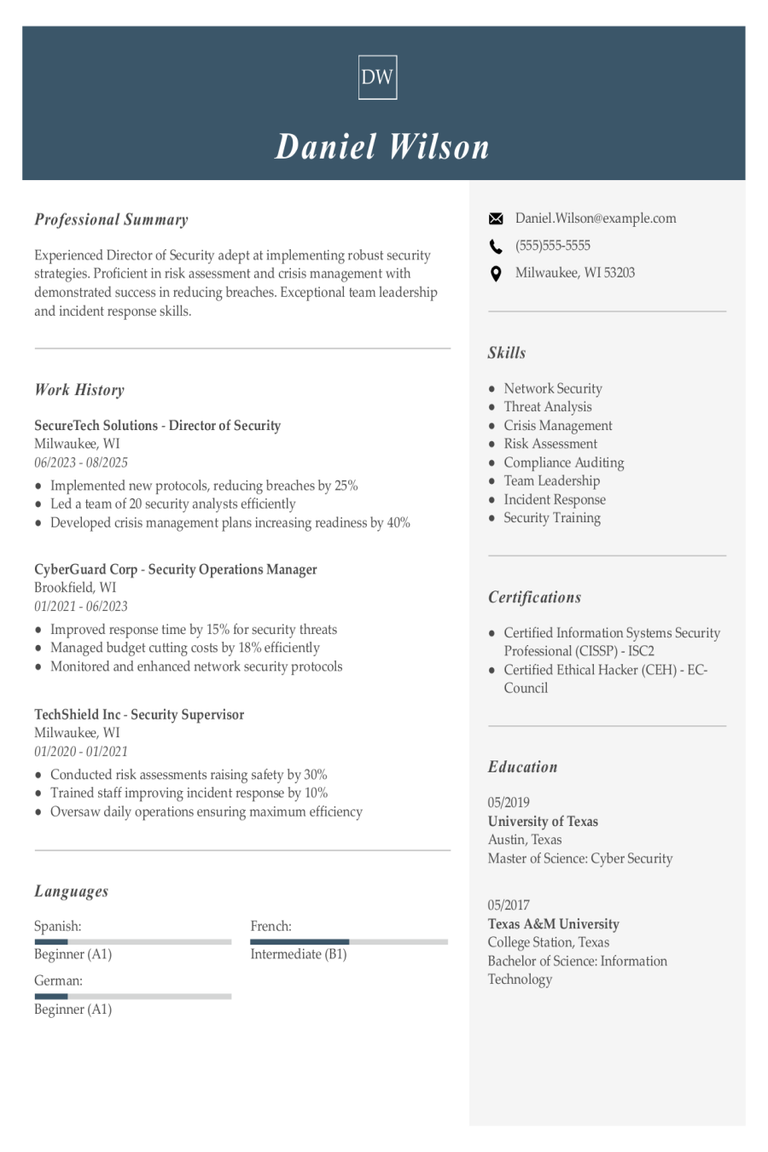
Director of Security Resume Examples & Templates for 2025
Check out director of security resume examples that focus on managing safety, risk assessment, and team leadership. Discover how to show employers you’re experienced in protecting assets and leading security
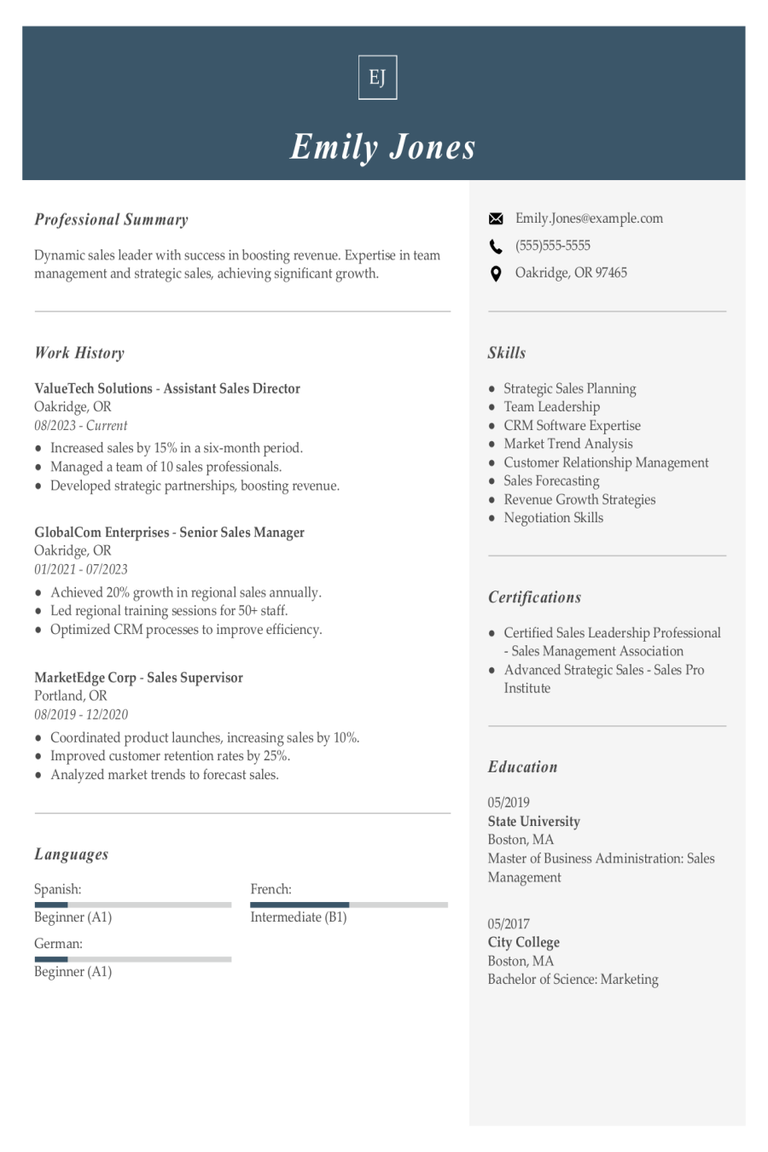
Assistant Sales Director Resume Examples & Templates for 2025
Assistant sales director resume examples show you how to highlight leadership skills and sales achievements. Learn to clearly showcase your experience in managing teams and boosting sales without sounding too
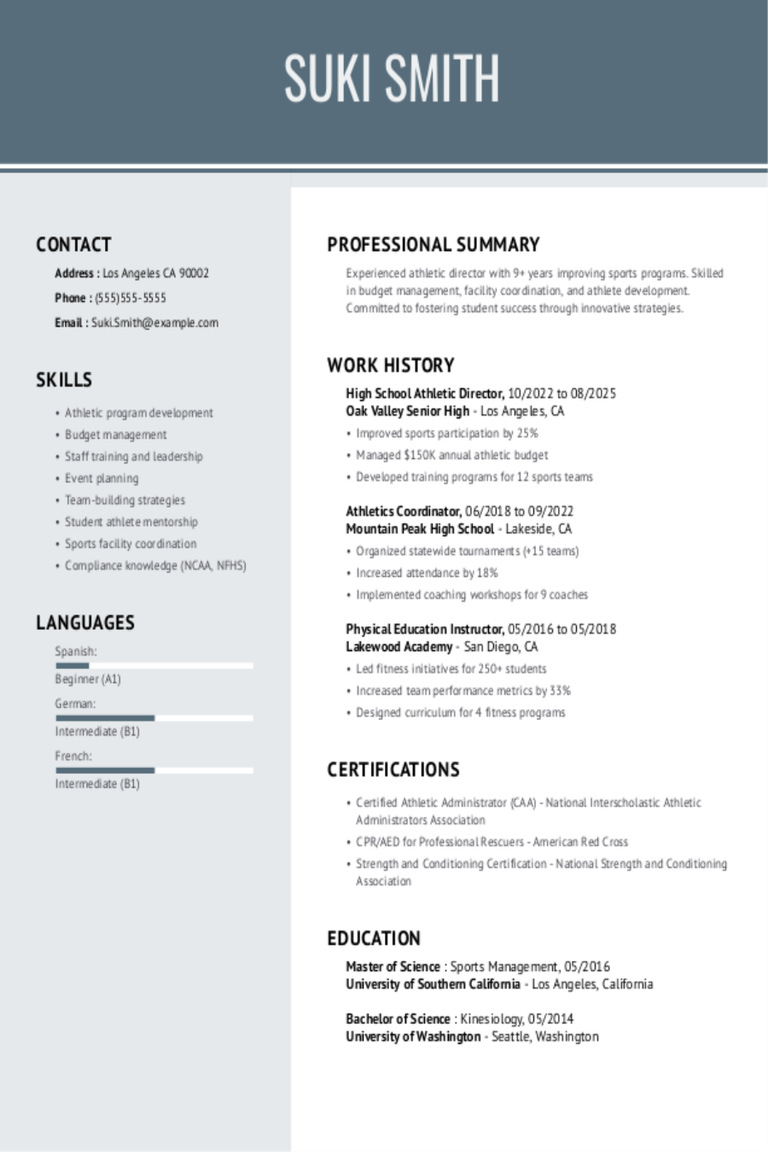
High School Athletic Director Resume Examples & Templates for 2025
Browse high school athletic director resume examples and learn how to show you manage sports programs, support student-athletes, and lead teams.Build my resumeImport existing resumeCustomize this templateWhy this resume
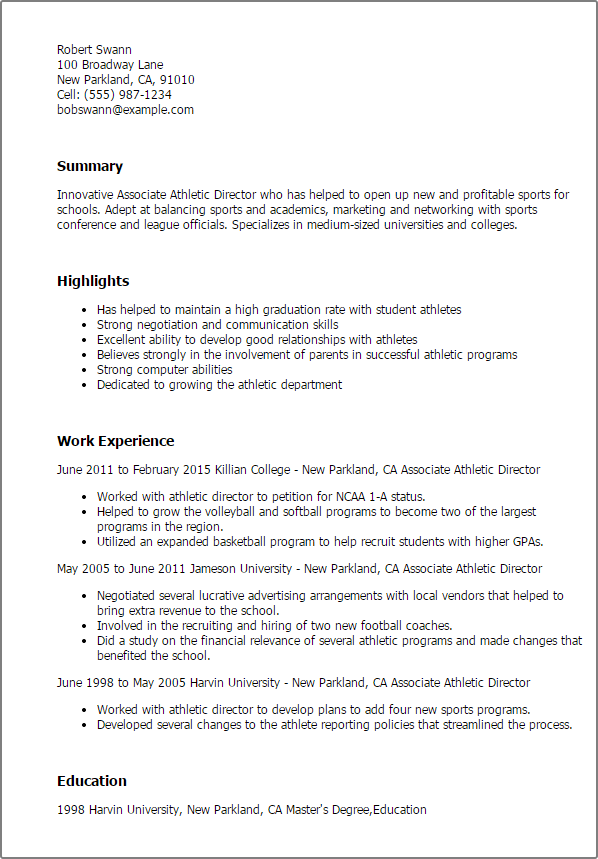
Athletic Director Resume Examples & Templates for 2025
Explore athletic director resume examples that focus on managing sports programs and leading teams. These tips will help you show your leadership skills and highlight your experience in sports management.Build
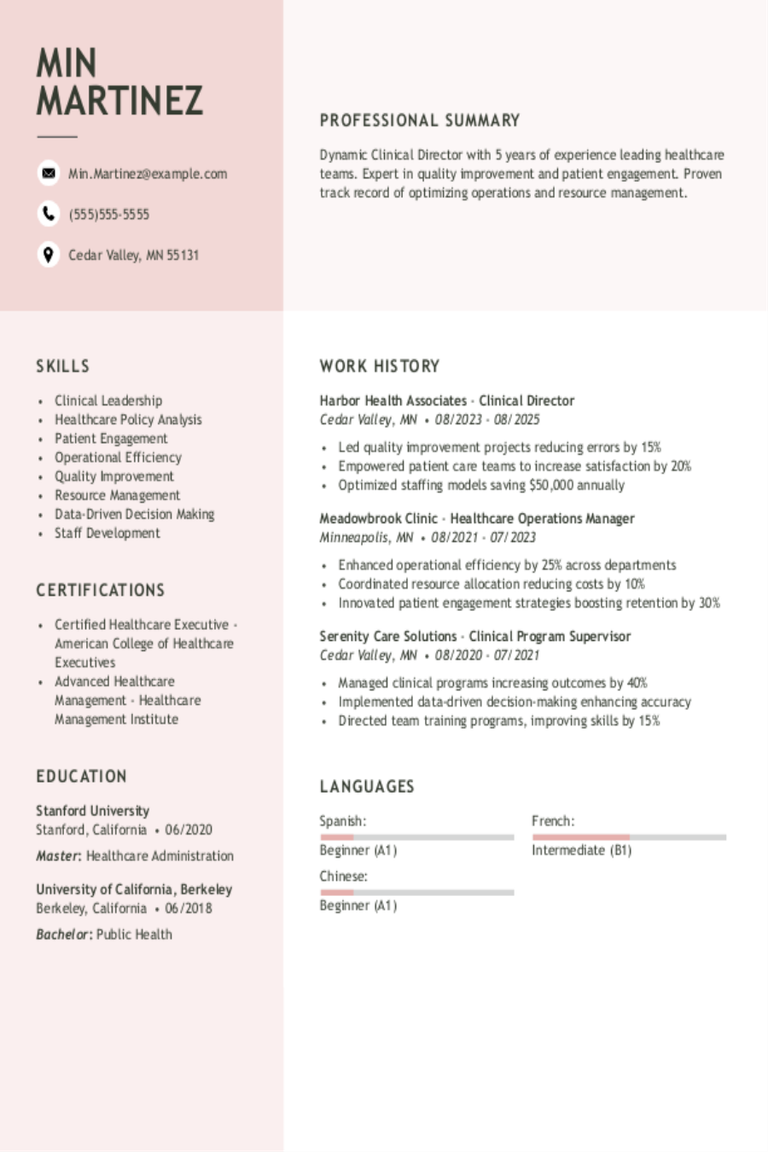
Clinical Director Resume Examples & Templates for 2025
Explore clinical director resume examples that show how to highlight your experience leading teams, managing healthcare operations, and improving patient care. Discover tips to showcase your leadership skills and experience
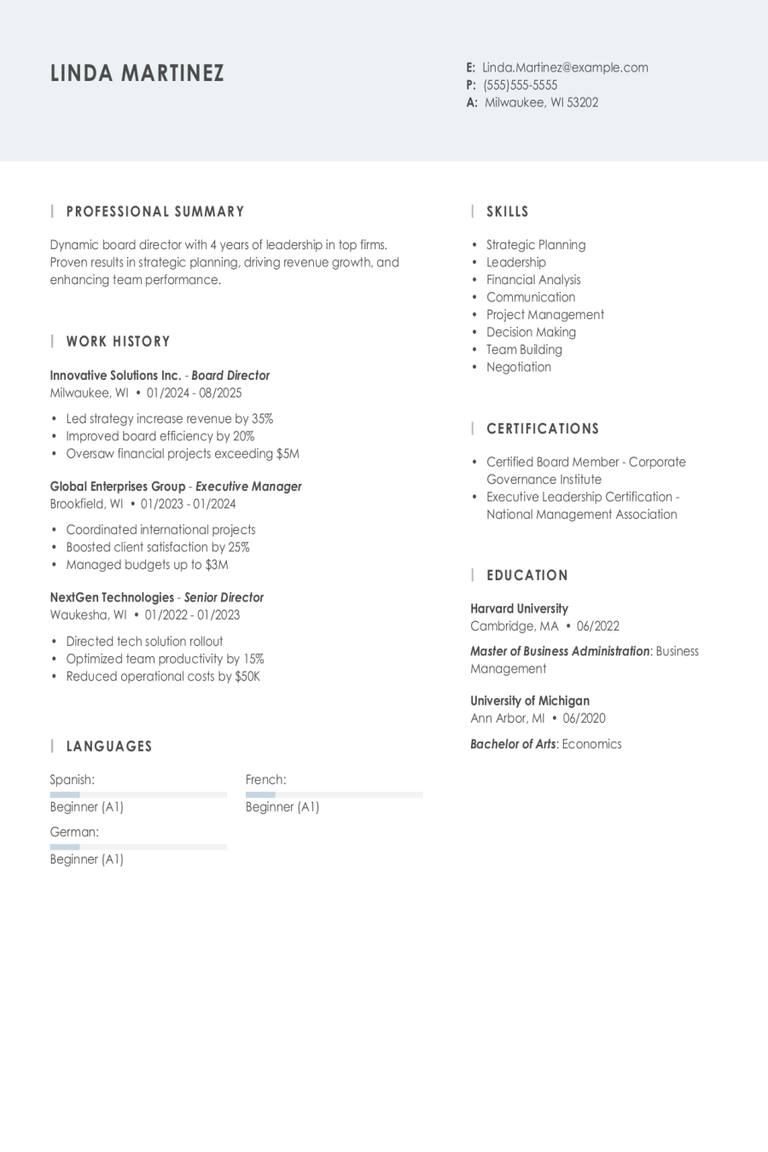
Board Director Resume Examples & Templates for 2025
Explore board director resume examples and learn how to showcase leadership, strategic planning, and team collaboration.Build my resumeImport existing resumeCustomize this templateWhy this resume worksQuantifies accomplishments: By pulling actual metrics like
